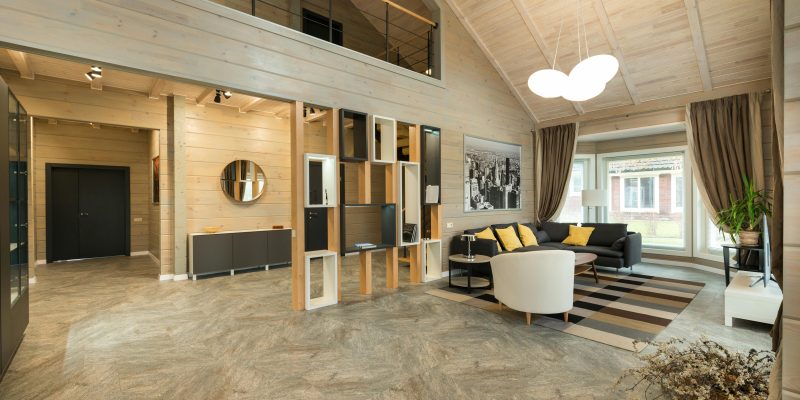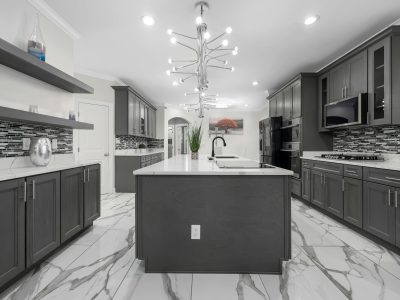Transitional interior design is a design style that combines elements of both traditional and contemporary styles. It offers timeless charm with a modern, minimalist finish, producing warm, inviting spaces. This method appeals to anyone?seeking equilibrium in their interior, striking a neutral balance while presenting an integrated, serene space.
Transitional Home Interior Design:?Key Features
It’s?a balancing act; transitional interior design is all about harmony with just a hint of contrast. It maintains the flexibility and adaptability that we require in a modern house, unlike a purely modern or purely traditional style. Key features include:
- Neutral colour palettes: The base is composed of soft shades of beige, grey, or white. These hues are soothing and allow accents to stand out.
- Minimalistic Lines and Forms: The background and furniture feature sleek lines with minimal detailing. It’s not that their elements or shapes are?sharp or rigid; they are often gentle and rounded.
- Mixed materials: A?variety of materials – wood, metal, glass, and fabric keep this space from feeling one-dimensional. This combination enhances aesthetics while maintaining continuity.
- Essential Accessories: Art & Mirrors?& Lighting, and More Accessories add to the room without adding?too much.
Furniture Choices in Transitional Spaces
Transitional design relies?heavily on furniture. Everything has been chosen for both form and function, with an emphasis on comfort, but it also looks good. Common characteristics include:
- Mixed Styles: Chairs, sofas, and tables are often a combination of traditional curves with contemporary finishes.
- Neutral Upholstery: Soft fabrics (like?linen or cotton) in neutral colours add an element of warmth.
- Functional Layouts: Furniture is placed with flow and use in mind, and?you can never have too many open spaces.
Transitions in?style create the opportunity for a timeless appeal that is always sophisticated, ultimately able to change with the times without sacrificing refinement.
Colour and Texture Balance
Muted, harmonious tones are often?chosen for transitional interiors. Accent colours that add warmth or interest are placed against neutral?walls. Pillows, throws, or decorative items are usually done in soft blues, greens, or even metallics.
The?texture part is also essential. The sleek surfaces of glass and polished wood offset soft fabrics and natural fibres without overstimulating the senses. The balance creates a layering of compositions that feels intimate yet intentional.
Lighting and Ambience
Comfort and function are key in transitional interiors, as is effective lighting. Furthermore, additional ambient, task, and accent lighting keep the space functional yet stylish. Key strategies include:
- Feature Fixtures: Go subtle with chandeliers and pendant lights to add glamour.
- Layered illumination, including table lamps, floor lamps, and recessed lights, comes with a soft, inviting, and excellent ambience.
- Incorporation of Natural Light: Large windows or minimal treatment of them permit natural light to shine through textures and colours.
- Such tools aid?in the airy quality and balance of transitional interiors.
Decorating Tips
A transitional interior calls for restraint in decoration and a careful choice?of items. Suggestions include:
- Art: Invest in timeless subjects (think landscape, still life, and portraiture) that are styled and presented in a way that is fresh and original now.
- Rugs: Neutral or softly patterned rugs can help pull the space together and add warmth.
- Plants and a Bit of Greenery: A carefully arranged Greenery adds an element of freshness without overwhelming the decor.
- Mirrors: These can be an important factor in both lighting and the illusion of space.
Instead, let your furniture and finishes be the highlight of a room, and the décor be the supporting actor.
Conclusion
This means that transitional interior design is the best solution for spaces to strike the perfect balance between timeless and contemporary. It fuses the elegance of tradition with the simplicity of?the modern to create a harmonious dwelling for living, working, or entertaining. The emphasis on balance, comfort, and discreet elegance makes it attractive to anyone seeking a timeless style.
By paying close attention to your choices of furniture, colour, texture, and lighting, any room can have a transitional appearance that is both cohesive and inviting. It offers flexibility, allowing for the development of any number of changeable?elements over time, while still maintaining a unified appearance. Transitional interior design demonstrates that a deliberate space can serve a purposeful mindset — providing elegance without the extra fuss.













Comments